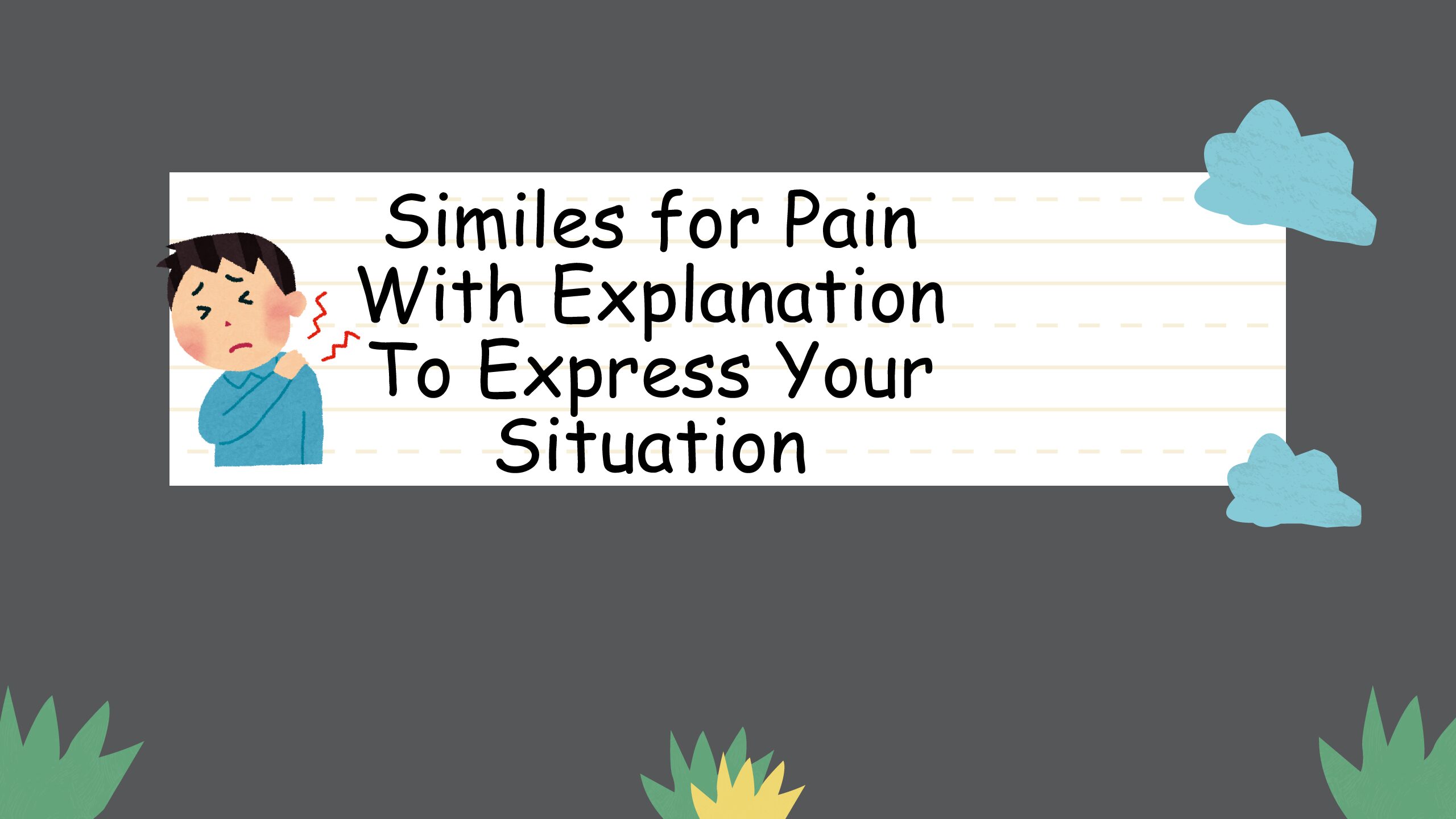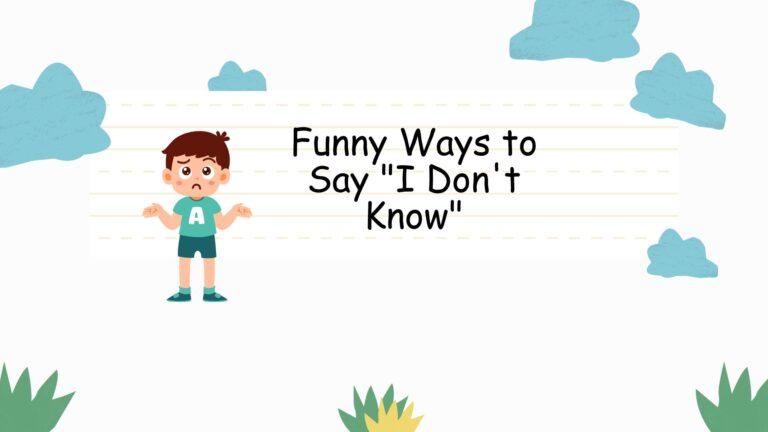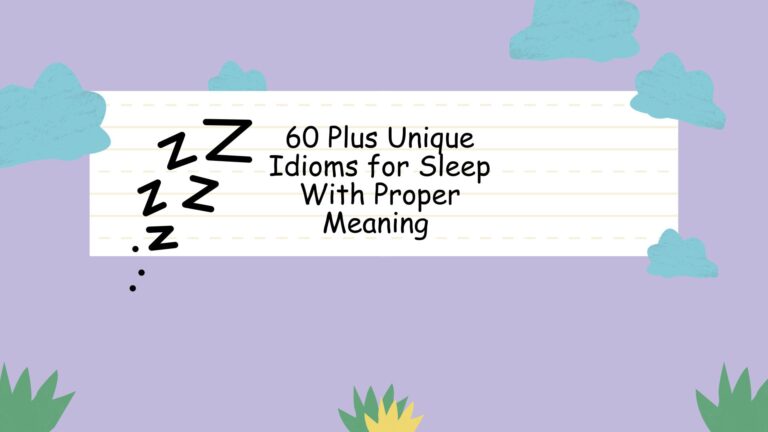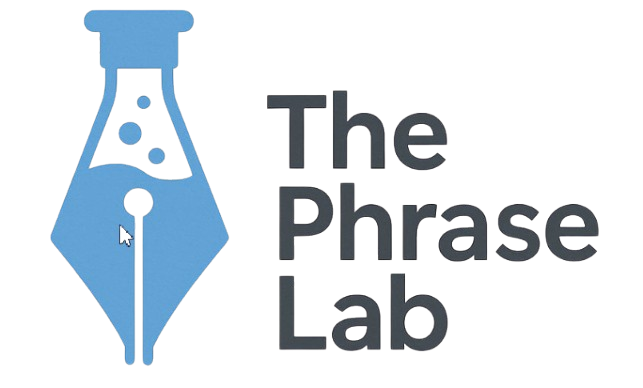
Metaphors for Bad: A Comprehensive Guide
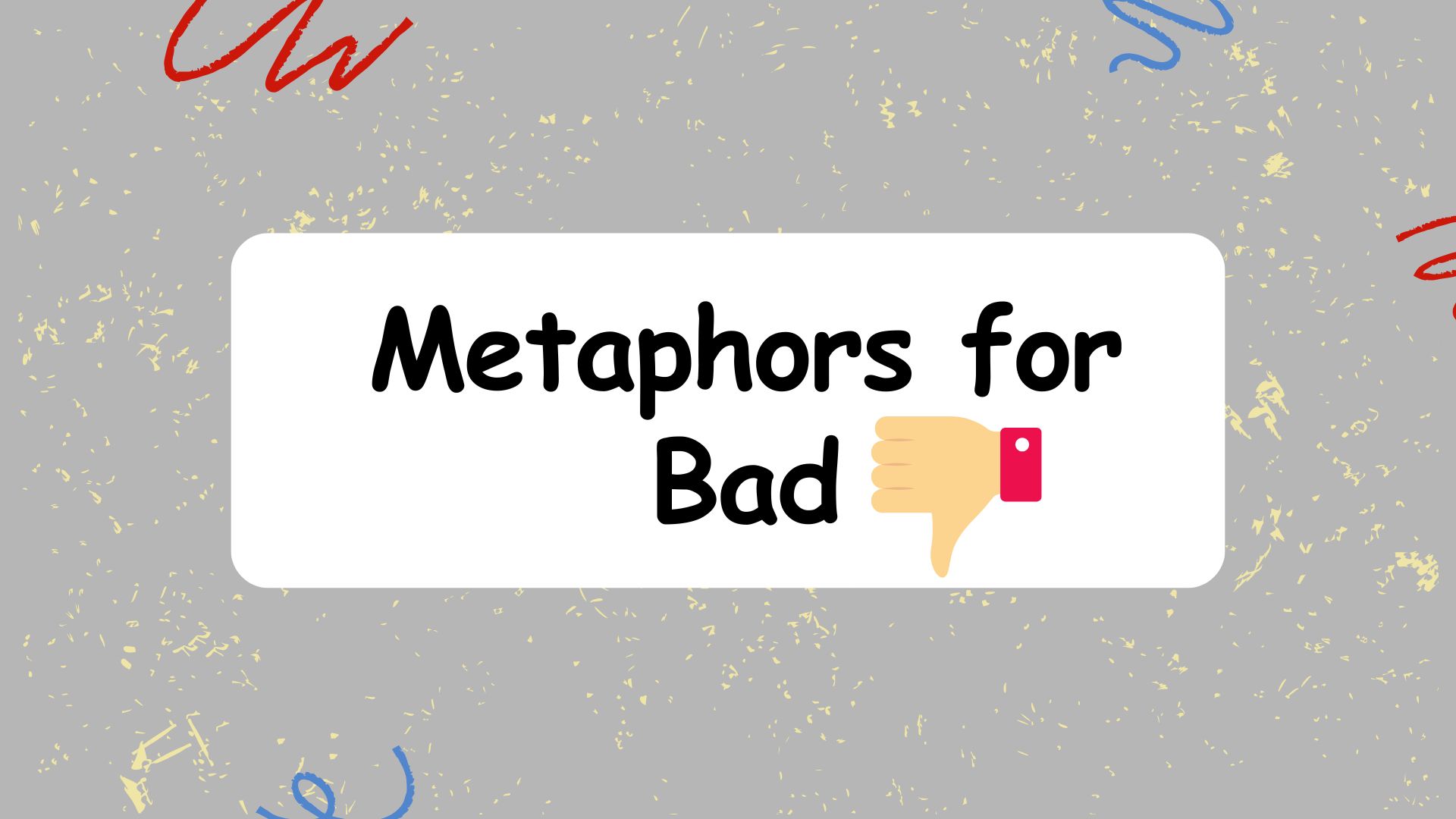
Metaphors are powerful tools that enrich our language, allowing us to express abstract ideas and emotions in vivid and relatable ways. When it comes to describing something “bad,” metaphors offer a spectrum of colorful alternatives to simple adjectives like “poor” or “terrible.” Understanding these metaphors not only expands your vocabulary but also enhances your ability to communicate with nuance and impact. This article delves into a wide range of metaphors for “bad,” exploring their meanings, usage, and the subtle differences that make each one unique. Whether you’re a student, writer, or language enthusiast, this guide will equip you with the knowledge to use metaphors for “bad” effectively and creatively.
Table of Contents
- Introduction
- Definition of Metaphor
- Structural Breakdown of Metaphors
- Types of Metaphors for “Bad”
- Examples of Metaphors for “Bad”
- Usage Rules for Metaphors
- Common Mistakes with Metaphors
- Practice Exercises
- Advanced Topics in Metaphorical Usage
- Frequently Asked Questions
- Conclusion
Definition of Metaphor
A metaphor is a figure of speech that directly compares two unrelated things without using “like” or “as.” It asserts that one thing is another, creating a vivid image or understanding. Metaphors are essential in communication because they allow complex or abstract concepts to be understood in terms of something more concrete and familiar. They add depth, color, and emotional resonance to language, making it more engaging and memorable.
Metaphors function by transferring qualities or characteristics from one thing (the source domain) to another (the target domain). For instance, saying “He is a lion in battle” doesn’t mean he’s literally a lion, but it uses the lion’s characteristics of bravery and strength to describe his behavior in battle. The effectiveness of a metaphor depends on the audience’s familiarity with the source domain and their ability to recognize the implied comparison.
Metaphors can be classified into several types, including:
- Standard Metaphors: Common and widely understood comparisons (e.g., “time is money”).
- Novel Metaphors: Original and creative comparisons that offer a fresh perspective.
- Dead Metaphors: Metaphors that have become so common that they are no longer recognized as metaphors (e.g., “the leg of a table”).
- Mixed Metaphors: Combining two or more inconsistent metaphors, which can be confusing or humorous (often unintentionally).
Structural Breakdown of Metaphors
Understanding the structure of a metaphor is crucial for effectively using and interpreting them. A metaphor essentially consists of two main components: the tenor and the vehicle. The tenor is the subject to which metaphorical attributes are ascribed. It is the thing being described. The vehicle is the object whose attributes are borrowed. It is the thing used to describe the tenor.
For example, in the metaphor “The world is a stage,” “the world” is the tenor, and “a stage” is the vehicle. The metaphor suggests that the world shares characteristics with a stage, such as having actors (people), roles (jobs), and a script (life events).
The ground is the shared characteristics or similarities between the tenor and the vehicle. In the example above, the ground includes the idea of performance, roles, and a structured narrative. The clearer the ground, the more effective the metaphor.
The effectiveness of a metaphor also depends on the context in which it is used. The same metaphor can have different meanings or connotations depending on the situation and the audience. Therefore, it’s important to consider the context when creating or interpreting metaphors.
Types of Metaphors for “Bad”
Metaphors for “bad” come in many forms, each evoking a different aspect of negativity. These metaphors can be grouped into several categories, depending on the specific nuance they convey.
Decay and Rot
Metaphors of decay and rot suggest a gradual decline or deterioration. They imply that something that was once good or healthy has become corrupted or spoiled. These metaphors often emphasize the unpleasantness and inevitability of decline.
Darkness and Shadow
Metaphors of darkness and shadow evoke feelings of mystery, fear, and uncertainty. They suggest hidden dangers or malevolent forces at work. These metaphors are often used to describe situations that are morally questionable or ethically ambiguous.
Disease and Illness
Metaphors of disease and illness imply that something is spreading and causing harm. They suggest that a problem is not isolated but is infecting other areas or people. These metaphors often emphasize the need for a cure or intervention.
Storms and Natural Disasters
Metaphors of storms and natural disasters convey a sense of chaos, destruction, and overwhelming force. They suggest that a situation is out of control and causing widespread damage. These metaphors often emphasize the powerlessness of individuals in the face of adversity.
Obstacles and Burdens
Metaphors of obstacles and burdens suggest that something is hindering progress or causing difficulty. They imply that a situation is challenging and requires effort to overcome. These metaphors often emphasize the weight or difficulty of a problem.
Inferiority and Worthlessness
Metaphors of inferiority and worthlessness suggest that something lacks value or importance. They imply that a situation is inadequate or disappointing. These metaphors often emphasize the lack of quality or merit.
Examples of Metaphors for “Bad”
To illustrate the different types of metaphors for “bad,” here are several examples organized by category. Each example demonstrates how a specific metaphor can be used to convey a particular nuance of negativity.
Decay Examples
The following table provides examples of metaphors for “bad” that fall under the category of decay and rot. These metaphors often describe situations or things that are deteriorating or becoming corrupt.
| Metaphor | Example Sentence | Explanation |
|---|---|---|
| A festering wound | The corruption in the government was a festering wound on the nation. | Implies that the corruption is getting worse and causing widespread harm. |
| A rotten apple | One rotten apple can spoil the whole barrel. | Suggests that one bad influence can corrupt an entire group. |
| A crumbling edifice | The company’s reputation was a crumbling edifice after the scandal. | Indicates that the company’s reputation is falling apart. |
| A decaying corpse | His dreams were like a decaying corpse, long forgotten and lifeless. | Suggests that his dreams are dead and beyond revival. |
| A tarnished reputation | The politician’s career suffered a tarnished reputation after the bribery accusations. | Indicates that the politician’s reputation has been damaged. |
| A withered flower | Her hopes were like a withered flower, once vibrant but now faded. | Suggests that her hopes have died and lost their vitality. |
| A moldy loaf | The relationship had become a moldy loaf, stale and unpleasant. | Implies that the relationship is no longer fresh or enjoyable. |
| Rusting away | His talent was rusting away from lack of practice. | Indicates that his talent is deteriorating due to neglect. |
| Going to seed | The once-grand estate was now going to seed, overgrown and neglected. | Suggests that the estate is falling into disrepair. |
| A putrid stench | The atmosphere in the office had a putrid stench of resentment. | Implies that there is a strong feeling of bitterness and animosity. |
| A blighted landscape | The economic downturn left a blighted landscape of closed businesses and unemployment. | Indicates that the economic situation is causing widespread devastation. |
| A corroded soul | His experiences had corroded his soul, leaving him cynical and bitter. | Suggests that his experiences have damaged his moral character. |
| A decomposing body | The project was like a decomposing body, its initial promise now a distant memory. | Implies that the project has failed and is beyond recovery. |
| A gangrenous limb | The outdated policies were a gangrenous limb, threatening the health of the entire organization. | Suggests that the policies are toxic and endangering the organization. |
| A spoiled harvest | The strike resulted in a spoiled harvest, leaving the farmers with nothing to sell. | Indicates that the strike has ruined the farmers’ livelihood. |
| A tainted reputation | The scandal left a tainted reputation on the entire industry. | Implies that the entire industry’s image has been damaged. |
| A rotting foundation | Their marriage was built on a rotting foundation of lies and secrets. | Suggests that their marriage is unstable and likely to fail. |
| A festering sore | The unresolved conflict was a festering sore between the two countries. | Indicates that the conflict is causing ongoing pain and resentment. |
| A decaying empire | The once-powerful empire was now a decaying empire, weakened by internal strife. | Implies that the empire is in decline and losing its power. |
| A withering spirit | The constant criticism had left her with a withering spirit. | Suggests that she has lost her enthusiasm and motivation. |
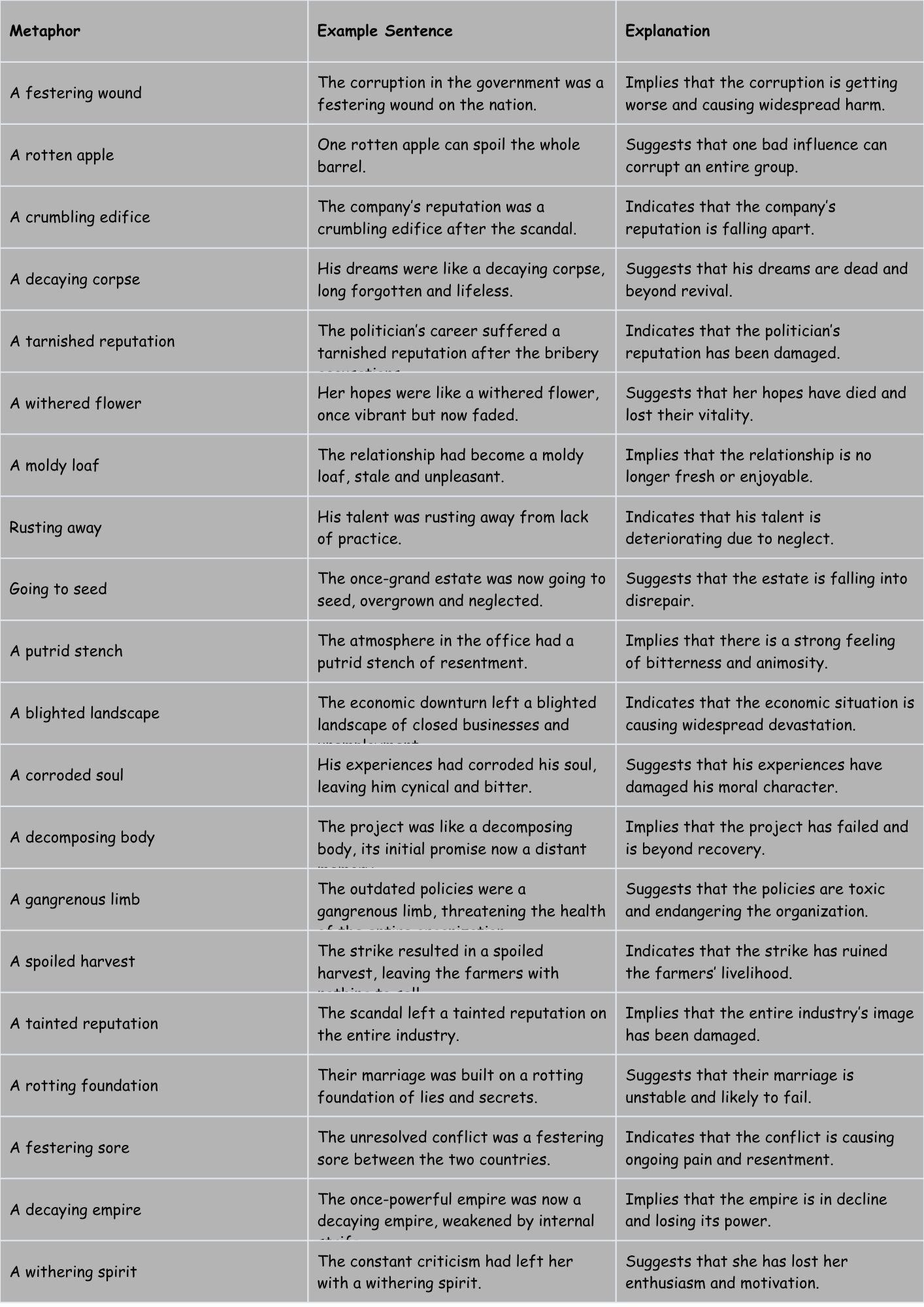
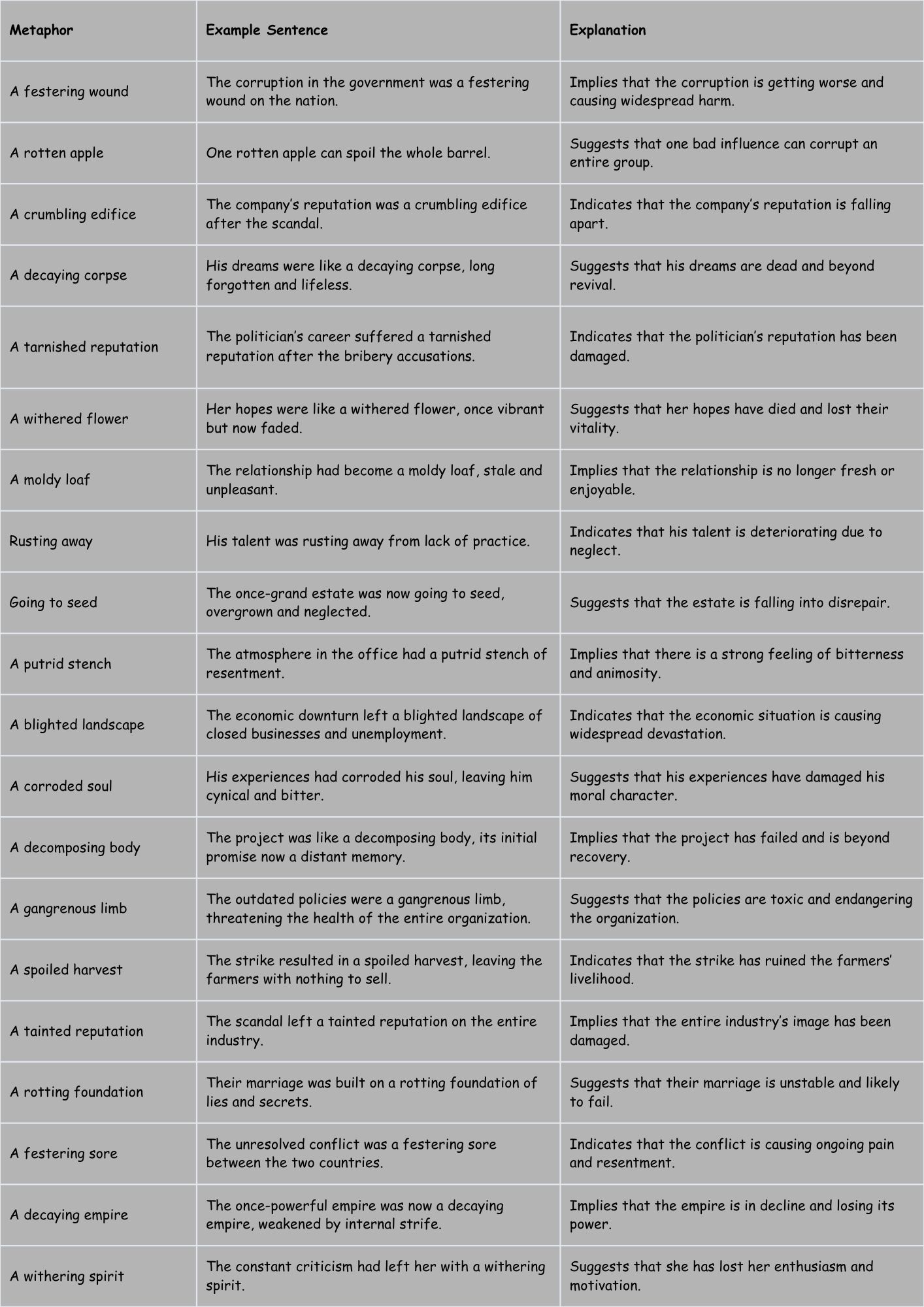
Darkness Examples
The following table provides examples of metaphors for “bad” that fall under the category of darkness and shadow. These metaphors often describe situations shrouded in mystery, fear, or moral ambiguity.
| Metaphor | Example Sentence | Explanation |
|---|---|---|
| A dark cloud | A dark cloud hung over their future after the diagnosis. | Suggests a sense of foreboding and uncertainty. |
| A shadow of doubt | A shadow of doubt lingered in her mind about his intentions. | Indicates a feeling of suspicion or mistrust. |
| A descent into darkness | His addiction led him on a descent into darkness. | Implies a progression towards a negative or destructive state. |
| A murky situation | The business deal was a murky situation with hidden clauses. | Suggests a lack of clarity and potential deception. |
| A black mark | The scandal left a black mark on his record. | Indicates a permanent stain or blemish on his reputation. |
| A nightmarish scenario | The economic collapse was a nightmarish scenario for the country. | Implies a situation of extreme distress and fear. |
| A twilight zone | The legal loophole existed in a twilight zone of ambiguity. | Suggests a state of uncertainty and lack of clear rules. |
| A bottomless pit | The company’s debt was a bottomless pit, consuming all their resources. | Indicates a situation with no end in sight. |
| A sea of despair | After the loss, she was lost in a sea of despair. | Suggests a feeling of overwhelming sadness and hopelessness. |
| A moral abyss | The dictator plunged his country into a moral abyss. | Implies a state of extreme moral corruption. |
| A dark age | The period was considered a dark age for scientific advancement. | Indicates a time of decline or stagnation. |
| A shadowy figure | The informant was a shadowy figure with unknown motives. | Suggests a person with a hidden or suspicious nature. |
| A bleak outlook | The company faced a bleak outlook due to declining sales. | Implies a pessimistic or unfavorable forecast. |
| A dark secret | The family was haunted by a dark secret from the past. | Suggests a hidden and troubling truth. |
| A shroud of mystery | The disappearance was shrouded in mystery. | Indicates a lack of clear information or explanation. |
| A dark side | Every hero has a dark side. | Suggests that even good people have flaws or negative aspects. |
| A world of shadows | The spy lived in a world of shadows and deception. | Implies a life of secrecy and danger. |
| A dark omen | The unexpected failure was seen as a dark omen for the future. | Suggests a sign of impending doom or misfortune. |
| A black hole | The project became a black hole for resources, never yielding results. | Indicates something that consumes everything without giving back. |
| A veil of ignorance | The decision was made under a veil of ignorance about the consequences. | Suggests a lack of awareness or understanding. |
Disease Examples
The following table provides examples of metaphors for “bad” that fall under the category of disease and illness. These metaphors often describe situations that are spreading, harmful, and in need of intervention.
| Metaphor | Example Sentence | Explanation |
|---|---|---|
| A spreading contagion | Fear was a spreading contagion among the population. | Suggests that fear is rapidly spreading and affecting many people. |
| A toxic environment | The workplace had become a toxic environment due to constant conflict. | Implies that the environment is harmful and unhealthy. |
| An infectious lie | The politician’s lie was an infectious lie that spread through the media. | Suggests that the lie is easily believed and disseminated. |
| A plague of corruption | The country was suffering from a plague of corruption. | Indicates that corruption is widespread and devastating. |
| A cancerous growth | The bureaucracy had become a cancerous growth within the organization. | Implies that the bureaucracy is expanding uncontrollably and harming the organization. |
| A viral rumor | The rumor spread like a viral rumor throughout the school. | Suggests that the rumor is spreading rapidly and uncontrollably. |
| A sick society | The novelist depicted a sick society plagued by inequality and injustice. | Implies that the society is morally or ethically unhealthy. |
| A festering problem | Unemployment remained a festering problem in the region. | Suggests that the problem is getting worse and causing ongoing harm. |
| A debilitating habit | His gambling addiction was a debilitating habit that ruined his life. | Implies that habit is weakening and destroying his life. |
| A paralyzing fear | The fear of failure was a paralyzing fear that prevented her from taking risks. | Suggests that fear is preventing her from acting or moving forward. |
| An epidemic of violence | The city was experiencing an epidemic of violence. | Indicates that violence is widespread and increasing rapidly. |
| A diseased mind | The murderer was described as having a diseased mind. | Implies that the murderer’s mental state is disturbed and harmful. |
| A chronic issue | Poverty is a chronic issue in many developing countries. | Suggests that poverty is a long-term and persistent problem. |
| A malignant influence | His older brother was a malignant influence on him. | Implies that the older brother is having a harmful effect. |
| A systemic flaw | The problem was identified as a systemic flaw in the organization. | Suggests that the problem is inherent in the structure or system. |
| An ailing economy | The country was struggling with an ailing economy. | Implies that the economy is weak and unhealthy. |
| A broken system | The justice system was described as a broken system. | Suggests that the justice system is not functioning properly. |
| A wounded heart | She was nursing a wounded heart after the breakup. | Implies that she is emotionally hurt and grieving. |
| A poisoned relationship | Their relationship had become a poisoned relationship due to jealousy. | Suggests that the relationship is harmful and destructive. |
| A festering wound | The unresolved conflict was a festering wound between the two countries. | Indicates that the conflict is causing ongoing pain and resentment. |
Storm Examples
The following table provides examples of metaphors for “bad” that fall under the category of storms and natural disasters. These metaphors often describe situations that are chaotic, destructive, and overwhelming.
| Metaphor | Example Sentence | Explanation |
|---|---|---|
| A raging storm | The market crash was a raging storm that swept away fortunes. | Suggests a period of intense chaos and destruction. |
| A financial tsunami | The global recession was a financial tsunami that devastated economies. | Implies a sudden and overwhelming economic crisis. |
| An erupting volcano | His anger was like an erupting volcano, spewing out fury and resentment. | Suggests a sudden and violent outburst of emotion. |
| A devastating earthquake | The scandal was a devastating earthquake that shook the foundation of the company. | Indicates a sudden and catastrophic event that disrupts everything. |
| A flood of criticism | The movie received a flood of criticism from reviewers. | Suggests an overwhelming amount of negative feedback. |
| A whirlwind of emotions | She was caught in a whirlwind of emotions after the news. | Implies a chaotic and overwhelming mix of feelings. |
| A destructive hurricane | The new policies were a destructive hurricane for small businesses. | Suggests that the policies are causing widespread damage and disruption. |
| A drought of creativity | The artist was experiencing a drought of creativity. | Implies a prolonged period of lacking new ideas or inspiration. |
| A blizzard of paperwork | The new regulations resulted in a blizzard of paperwork. | Suggests an overwhelming amount of administrative tasks. |
| A landslide victory | Although a victory, it caused a landslide of problems. | Implies that winning actually caused a lot of issues. |
| Under siege | The city was under siege by enemy forces. | Suggests a situation of being surrounded and attacked. |
| A perfect storm | A perfect storm of factors led to the company’s downfall. | Implies that multiple negative events combined to create a disastrous outcome. |
| A tempestuous relationship | Their relationship was a tempestuous relationship filled with drama. | Suggests that the relationship is volatile and prone to conflict. |
| A crumbling infrastructure | The city’s crumbling infrastructure was a major concern. | Implies that the city’s essential systems are deteriorating. |
| A heatwave of anger | A heatwave of anger swept through the country after the announcement. | Suggests a sudden and widespread surge of anger. |
| A tidal wave of support | The campaign was met with a tidal wave of support. | Suggests an overwhelming amount of positive feedback. |
| A seismic shift | The new technology caused a seismic shift in the industry. | Implies a major and transformative change. |
| A desert of opportunity | The region had become a desert of opportunity for young graduates. | Suggests a lack of available jobs or prospects. |
| A avalanche of debt | The family was buried under a avalanche of debt. | Implies that they are crushed by the weight of their financial obligations. |
| A fog of uncertainty | The future was shrouded in a fog of uncertainty. | Suggests a lack of clarity and direction. |
Obstacle Examples
The following table provides examples of metaphors for “bad” that fall under the category of obstacles and burdens. These metaphors often describe situations that hinder progress or cause difficulty.
| Metaphor | Example Sentence | Explanation |
|---|---|---|
| A stumbling block | Lack of funding was a major stumbling block for the project. | Suggests an obstacle that prevents progress. |
| A heavy burden | The responsibility of caring for her parents was a heavy burden. | Implies a weight or difficulty that is hard to bear. |
| A uphill battle | Starting a new business is always an uphill battle. | Suggests a difficult and challenging endeavor. |
| A thorn in the side | The constant complaints were a thorn in the side of the manager. | Implies a persistent annoyance or source of irritation. |
| A glass ceiling | Women still face a glass ceiling in many corporations. | Suggests an invisible barrier that prevents advancement. |
| A roadblock to success | The new regulations were a roadblock to success for small businesses. | Implies something that is stopping progress. |
| A quagmire of bureaucracy | The project was mired in a quagmire of bureaucracy. | Suggests a complex and difficult situation that is hard to escape. |
| A ball and chain | The debt was a ball and chain, preventing him from pursuing his dreams. | Implies a restriction or burden that limits freedom. |
| A dead weight | The unproductive employee was a dead weight on the team. | Suggests something that is hindering progress. |
| A albatross around his neck | The scandal became an albatross around his neck. | Implies a constant reminder of past mistakes. |
| A minefield of issues | The negotiation was a minefield of issues. | Suggests a situation fraught with danger and potential problems. |
| A complex maze | The legal system was a complex maze for the average person. | Implies a confusing and difficult system to navigate. |
| A swamp of confusion | The new policies created a swamp of confusion among employees. | Suggests a situation of uncertainty and lack of clarity. |
| A slippery slope | Allowing exceptions can lead to a slippery slope of corruption. | Implies a course of action that will inevitably lead to negative consequences. |
| A Gordian knot | The conflict had become a Gordian knot that no one could untangle. | Suggests a complex and seemingly unsolvable problem. |
| A stumbling stone | Pride can be a stumbling stone to success. | Implies that pride can hinder one’s progress. |
| A labyrinth of regulations | The business had to navigate a labyrinth of regulations to get started. | Suggests a complex and confusing set of rules. |
| A chain around his ankles | The past mistakes were a chain around his ankles, preventing him from moving forward. | Implies that past actions are holding him back. |
| An anchor dragging him down | Negativity was an anchor dragging him down. | Implies that his negative thoughts are preventing him from progressing. |
| A wall between them | Misunderstanding was a wall between them. | Indicates that they are unable to communicate with each other. |
Inferiority Examples
The following table provides examples of metaphors for “bad” that fall under the category of inferiority and worthlessness. These metaphors often describe situations that lack value or importance.
| Metaphor | Example Sentence | Explanation |
|---|---|---|
| A second-rate effort | The performance was a second-rate effort, lacking creativity and energy. | Suggests that the effort was of poor quality. |
| A pale imitation | The copy was a pale imitation of the original. | Implies that the copy is inferior to the original. |
| A waste of time | The meeting was a waste of time, with no decisions made. | Suggests that the meeting was unproductive and pointless. |
| A fool’s errand | Searching for the lost key was a fool’s errand. | Implies a pointless or futile task. |
| A empty promise | The politician’s promises were empty promises. | Suggests that the promises are meaningless and will not be fulfilled. |
| A paper tiger | The company was a paper tiger, lacking real power and influence. | Implies that the company appears strong but is actually weak. |
| A house of cards | The financial system was a house of cards, ready to collapse at any moment. | Suggests that the system is fragile and unstable. |
| A shadow of its former self | The once-great city was now a shadow of its former self. | Implies that the city has declined in importance and prosperity. |
| A flash in the pan | The band’s success was just a flash in the pan. | Suggests that the success was short-lived and unsustainable. |
| A drop in the bucket | The donation was a drop in the bucket compared to the need. | Implies that the donation was insignificant. |
| A dead end | The investigation was a dead end. | Suggests that the investigation will not lead to any results. |
| A broken reed | He was a broken reed, unable to support her in her time of need. | Implies that he is weak and unreliable. |
| A lost cause | Trying to convince him was a lost cause. | Suggests that it is futile to try to convince him. |
| A fool’s paradise | They were living in a fool’s paradise, unaware of the impending danger. | Implies a state of delusion or false hope. |
| A hollow victory | The victory was a hollow victory, achieved at too high a cost. | Suggests that the victory is meaningless or unsatisfying. |
| A castle in the air | His plans were just castles in the air, unrealistic and impractical. | Implies that his plans are based on fantasy rather than reality. |
| A fool’s gold | The investment turned out to be fool’s gold. | Suggests that the investment appeared valuable but was actually worthless. |
| A fly in the ointment | The minor mistake was a fly in the ointment. | Implies that the small error spoiled the overall result. |
| A paper-thin excuse | His excuse was a paper-thin excuse. | Suggests that his excuse was unconvincing and easily seen through. |
| A penny wise, pound foolish | Their decision was penny wise, pound foolish. | Implies that they saved a small amount of money but lost a larger amount in the long run. |
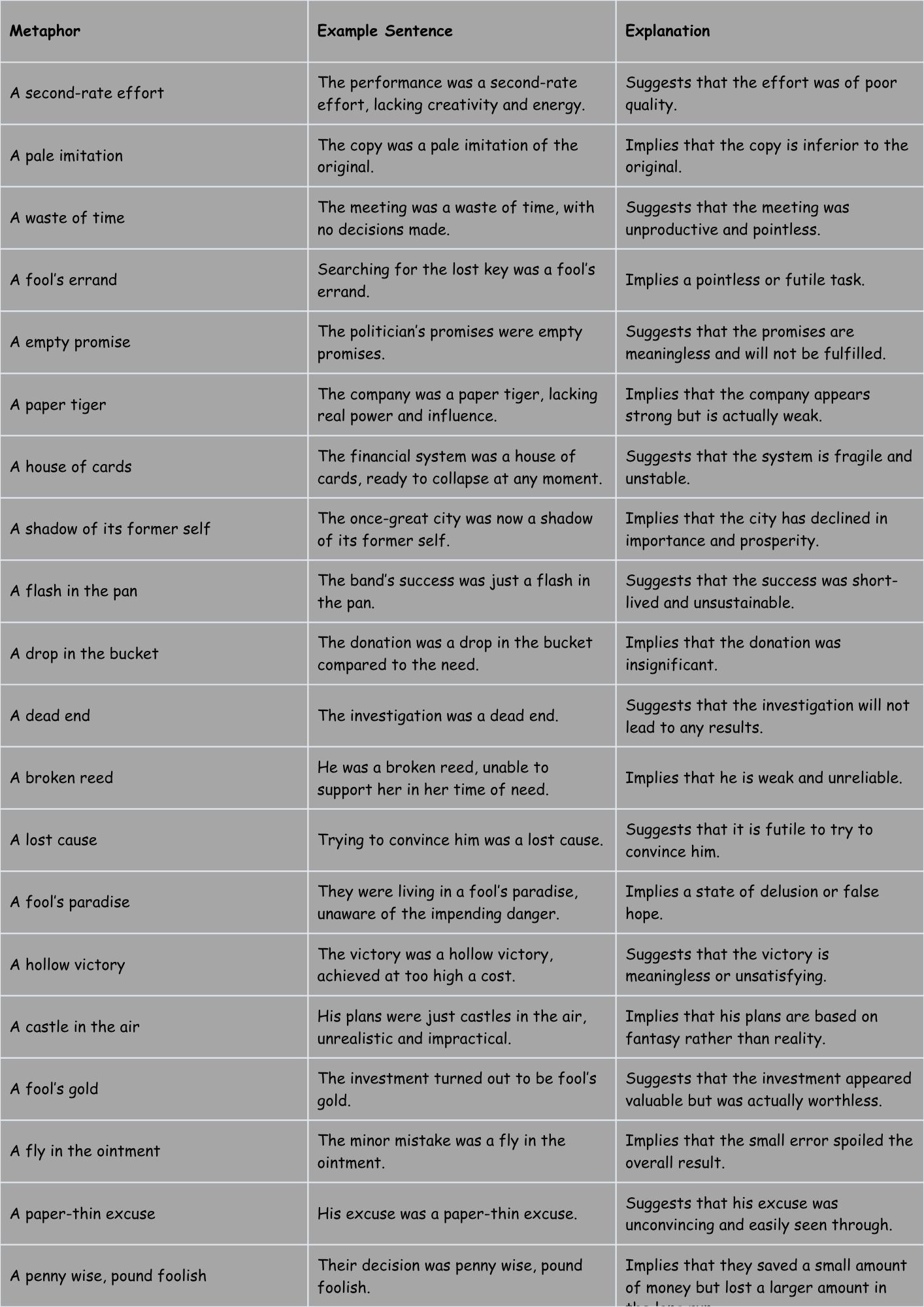
Usage Rules for Metaphors
Using metaphors effectively requires careful consideration of several factors. Here are some key usage rules to keep in mind:
- Clarity: The metaphor should be clear and easy to understand. Avoid using obscure or overly complex comparisons.
- Relevance: The metaphor should be relevant to the context and the audience. Choose metaphors that resonate with the situation and the people you are addressing.
- Originality: While common metaphors can be effective, try to use original metaphors to add freshness and impact to your writing or speech.
- Consistency: Avoid mixing metaphors that create contradictory or confusing images. Maintain a consistent metaphorical framework.
- Appropriateness: Consider the tone and formality of the situation. Some metaphors may be inappropriate for certain contexts.
- Overuse: Avoid overusing metaphors, as this can make your writing or speech seem contrived or artificial. Use them sparingly for maximum impact.
Common Mistakes with Metaphors
Several common mistakes can detract from the effectiveness of metaphors. Being aware of these errors can help you avoid them.
| Mistake | Incorrect Example | Correct Example |
|---|---|---|
| Mixed Metaphor | “We need to nip it in the bud before it snowballs out of control.” | “We need to nip it in the bud before it becomes a problem.” OR “We need to address it before it snowballs out of control.” |
| Clichéd Metaphor | “He was as brave as a lion.” | “He faced the challenge with unwavering courage.” |
| Inappropriate Metaphor | “The surgery was a walk in the park.” (when describing a serious operation) | “The surgery went smoothly, with minimal complications.” |
| Unclear Metaphor | “The project was a purple rhinoceros.” | “The project was an ambitious but ultimately impractical endeavor.” |
| Overused Metaphor | “Life is a journey. We must navigate the road ahead and reach our destination.” | “Life presents challenges that require resilience and determination.” |
Practice Exercises
Test your understanding of metaphors for “bad” with these practice exercises. Identify the
type of metaphor used in each sentence and explain its meaning.
- The company’s ethics were a festering wound.
- His temper was a raging storm.
- The project became a quagmire of bureaucracy.
- Her reputation was a tarnished reputation.
- The new policy was a roadblock to progress.
Advanced Topics in Metaphorical Usage
Beyond basic usage, several advanced topics can further refine your understanding and application of metaphors:
- Extended Metaphors: A metaphor that is sustained over several lines or paragraphs, creating a more complex and nuanced comparison.
- Conceptual Metaphors: Underlying cognitive structures that shape our understanding of abstract concepts in terms of more concrete ones (e.g., “argument is war”).
- Metaphorical Framing: Using metaphors to influence how people perceive and understand a situation or issue.
- Cross-Cultural Metaphors: Understanding how metaphors vary across different cultures and languages.
Frequently Asked Questions
What is the difference between a metaphor and a simile?
A metaphor directly equates two things (e.g., “He is a lion”), while a simile compares two things using “like” or “as” (e.g., “He is as brave as a lion”).
How can I create more original metaphors?
Look for unexpected connections between seemingly unrelated things. Consider the qualities or characteristics you want to convey and brainstorm objects or concepts that share those qualities.
Are some metaphors universally understood?
Some metaphors are widely understood due to shared cultural experiences, but many metaphors are culturally specific and may not translate well across different cultures.
How do I avoid mixing metaphors?
Pay close attention to the images and concepts your metaphors evoke. Ensure that they are consistent and do not create contradictory or nonsensical comparisons.
Can metaphors be used in formal writing?
Yes, metaphors can be used in formal writing, but they should be used judiciously and with careful consideration of the audience and the context.
Conclusion
Metaphors for “bad” offer a rich and varied palette for expressing negativity with nuance and impact. By understanding the different types of metaphors, their structural components, and the rules for effective usage, you can enhance your ability to communicate with greater precision and creativity. Whether you’re describing a decaying relationship, a stormy situation, or a worthless endeavor, the right metaphor can transform a simple statement into a powerful and memorable expression.

